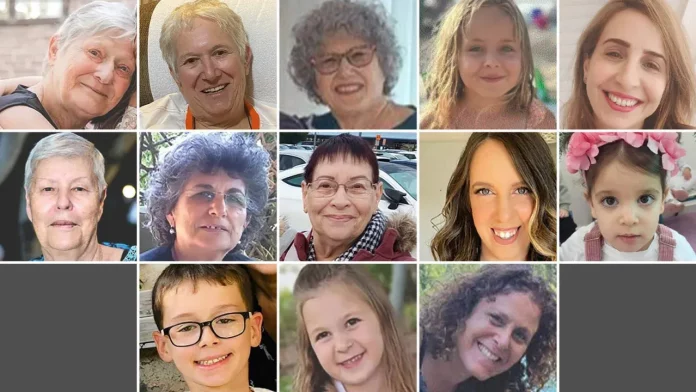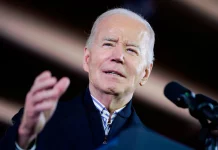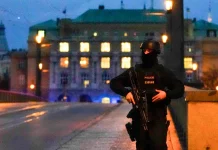
Gaza Strip — In the first phase of a prisoner exchange under a four-day cease-fire, Hamas freed 24 hostages from Gaza on Friday, while Israel released 39 Palestinians from jail, bringing some respite to both sides.
The release of 13 Israeli women and children, most of them elderly, and 11 foreign nationals from Gaza was met with jubilation in Israel, which had suffered the kidnapping of nearly 240 people in Hamas’ Oct. 7 raid that sparked the war.
The cease-fire, which began on Friday morning, also brought a rare calm to Gaza, where 2.3 million Palestinians have endured constant Israeli airstrikes that have killed thousands, displaced three-quarters of the population and destroyed entire neighborhoods. No rockets were fired from Gaza into Israel either.
As part of the deal, Gaza received more shipments of food, water, medicine and fuel, easing the dire humanitarian situation caused by Israel’s blockade of the territory.
However, the relief was short-lived and mixed — for Israelis, because not all hostages will be freed, and for Palestinians, because the truce is only temporary. Gaza remains in a state of crisis and faces the risk of renewed hostilities.
Israel has said that the cease-fire could be prolonged if more hostages are released, and Prime Minister Benjamin Netanyahu’s office announced that it had obtained a new list of hostages to be freed by Hamas on Saturday.
But Israel has also threatened to resume its large-scale assault once the truce expires. This has dampened hopes that the deal could pave the way for a lasting end to the conflict, which has triggered a wave of violence in the occupied West Bank and raised fears of a regional escalation.
Hostage Swap Begins Between Israel and Hamas
A four-day truce between Israel and Hamas has paved the way for a hostage swap that will see at least 50 Israelis and 150 Palestinians freed from captivity. The exchange, which began on Friday night, prioritized the release of women and children on both sides. Israel also agreed to extend the truce by one day for every 10 additional hostages released by Hamas.
Egypt’s state-run Al-Qahera TV broadcast live footage of a convoy of ambulances carrying the freed Israelis from Gaza to Egypt through the Rafah Crossing. Among the 13 hostages were nine women and four children under the age of 10.
The hostages were transferred to three Israeli hospitals for medical and psychological evaluation. The Schneider Children’s Medical Center reported that it was treating eight of the hostages — four women and four children — who were in good physical condition. The center also said that the families were going through “sensitive moments” as they reunited with their loved ones.
In Tel Aviv, a large crowd gathered at a plaza named “Hostages Square” to celebrate the news of the release.
Yael Adar was overjoyed to see her 85-year-old mother, Yaffa Adar, walking in a TV report of the release. She told Israel’s Channel 12 that she was worried about her mother’s health during the nearly two months of captivity. However, her son, Tamir Adar, 38, was still held by Hamas. He and his grandmother were abducted on Oct. 7 from Kibbutz Nir Oz, where about 80 people — nearly a quarter of the population — were taken hostage. “Everyone needs to come back. It’s happiness locked up in grief,” she said.
The hostages spanned multiple generations. Nine-year-old Ohad Munder-Zichri was freed along with his mother, Keren Munder, and grandmother Ruti Munder. The boy was kidnapped during a holiday visit to his grandparents’ kibbutz.
The hostage crisis has sparked anger among some families who accused the government of Prime Minister Benjamin Netanyahu of not doing enough to secure their release.
Later that night, 24 Palestinian women and 15 teenagers were released from Israeli prisons in the occupied West Bank and east Jerusalem. In the town of Beituna, hundreds of Palestinians celebrated the release by honking horns and setting off fireworks that illuminated the night sky.
The teenagers had been imprisoned for minor offenses such as stone-throwing. The women included some who had been convicted of attempting to stab Israeli soldiers, and others who had been arrested at checkpoints in the West Bank.
Abdulqader Khatib, a U.N. worker whose 17-year-old son, Iyas, was among the freed, said he was conflicted by the situation. “As a Palestinian, my heart is broken for my brothers in Gaza, so I can’t really celebrate,” he said. “But I am a father. And deep inside, I am very happy.”
Iyas had been held in “administrative detention” for a year, without charges or trial and based on secret evidence. Israel frequently detains Palestinians for months without charges. Most of those who face trial are brought before military courts that rarely acquit defendants and often violate due process, according to human rights groups.
The Palestinian Prisoners’ Club, an advocacy group, said that Israel is currently holding 7,200 Palestinians, including about 2,000 who were arrested since the start of the war.

CEASE-FIRE BRINGS RELIEF TO GAZA
The cease-fire that took effect on Friday morning gave Gaza’s displaced population a brief respite from the violence that has uprooted them for weeks. They used the opportunity to seek food, shelter and family members.
Israel said it allowed four trucks of fuel, four trucks of cooking gas and 200 trucks of humanitarian aid to enter Gaza from Egypt after the truce began.
Israel had imposed a blockade on Gaza during the war, only permitting a small amount of supplies from Egypt.
The lack of fuel, which Israel claimed could be used by Hamas, resulted in a complete power outage in Gaza. Essential services such as hospitals, water systems, bakeries and shelters faced difficulties in operating their generators.
Under the cease-fire deal, Israel agreed to supply 130,000 liters (34,340 gallons) of fuel per day to Gaza – still far below the territory’s estimated daily demand of more than 1 million liters.
More than half of Gaza’s 2.3 million people are crammed into the southern part of the strip, with over 1 million staying in U.N. schools that have been converted into shelters. The lull in hostilities allowed some of the residents of the south to return to their homes and collect some of their belongings.
However, those who had fled from the north to the south were advised by Israel not to go back, as Israeli forces still controlled much of the northern area, including Gaza City.
Despite the warning, hundreds of Palestinians attempted to walk north on Friday. Israeli soldiers shot and killed two of them and wounded another 11.
Sofian Abu Amer chose to take the risk and check on his home in Gaza City.
“We don’t have enough clothes, food and drinks,” he said. “The situation is disastrous. It’s better for a person to die.”
The northern border of Israel with Lebanon was also calm on Friday, a day after the militant group Hezbollah, a supporter of Hamas, launched the most attacks in a single day since the conflict there started on Oct. 8.
Hezbollah was not a signatory to the cease-fire agreement but was expected to stop its attacks.
A Brief Lull in the Conflict?
A violent conflict broke out when Hamas militants launched a massive attack on southern Israel, killing and kidnapping hundreds of civilians and soldiers.
The parties agreed to a temporary ceasefire, mediated by Qatar, the United States and Egypt, with the hope of ending the bloodshed.
However, Israel’s Defense Minister warned that the pause would be brief and that the war would continue for at least two more months.
Israel’s Prime Minister pledged to pursue the war until Hamas’ military infrastructure was destroyed, its control over Gaza was ended and all the captives were freed.
The Palestinian Health Ministry in Gaza reported that more than 13,300 Palestinians had been killed by the Israeli assault, mostly women and children. The number did not include the casualties in the northern areas, where communication was disrupted.
The ministry also said that some 6,000 people were missing, possibly buried under the rubble. It did not distinguish between civilians and combatants in its death toll.
Israel claimed that it had killed thousands of Hamas militants, but did not provide any proof for its claim.




